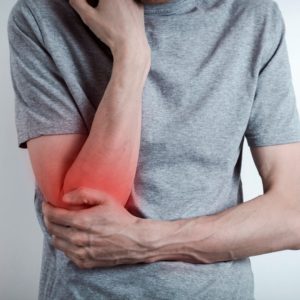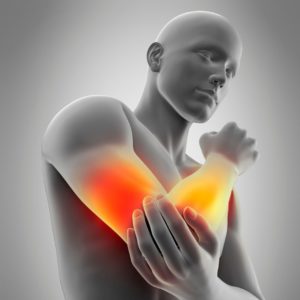“Never overestimate the strength of the torchbearer’s arm, for even the strongest arms grow weary.”
― A.J. Darkholme, Rise of the Morningstar
We take many things for granted when it comes to our bodies, such as breathing without intentional, conscious effort. Or, that our heart beats about 100,000 times a day.
But when pain makes an otherwise natural and seemingly effortless movement difficult or even impossible, we can’t help but take notice. Elbow pain can be one of these conditions. Normally, few of us give any thought to the fact that we flex and extend our elbow joints continuously to do just about everything with our arms.
Until it hurts to do so.
The Elbow Joint and Arm Movement
Our elbows may be joint structures we give little thought to, but they are vitally essential for our daily functioning in life.
So, what makes up this important but often neglected joint? According to the Washington University Orthopedics website,
“The elbow is a hinged joint made up of three bones, the humerus, ulna, and radius. The ends of the bones are covered with cartilage, and cartilage has a rubbery consistency that allows the joints to slide easily against one another and absorb shock. The bones are held together with ligaments that form the joint capsule.”
The elbow is a synovial hinge joint, similar to the ankle and knee joints, which connects our upper arm to the lower arm, enabling movement. The elbow is a complex structure consisting of bones, ligaments, nerves, and blood vessels.
We use our elbow joints extensively in daily life, but repetitive use or excessive strain on our elbow joints can result in pain and even injuries.
While the pain often diminishes and disappears over time in many instances, continued repetitive motion or undue strain can lead to chronic pain. Elbow pain can be caused by several factors, such as bursitis, tendonitis, and lateral epicondylitis.
Common Causes of Chronic Elbow Pain
Most of us have hit our elbows against something hard like a door jam or wall. While it can hurt, that type of elbow pain typically goes away after a short time.
But other sources of elbow pain can last weeks, months, or – in extreme cases – even years without treatment.
The most common conditions that cause chronic elbow pain include:
- Bursitis
- Sprains
- Golfer’s elbow
- Tennis elbow
- Trapped nerves
Elbow bursitis and tendonitis are typically the most common sources of pain that people experience outside of an actual injury to the elbow joint.
Elbow bursitis is marked by swelling at the tip of the elbow, which is the location of the olecranon bursa. This condition can result in pain, tenderness, and joint stiffness.
As one source explains,
“The olecranon bursa reduces friction between the skin and the end of the forearm’s ulna bone, called the olecranon. Elbow bursitis is typically caused by repeatedly resting weight on the elbow, and it has earned nicknames such as student’s elbow and miner’s elbow.”
So-called Golfer’s elbow and Tennis elbow are both forms of elbow tendonitis.
Tennis elbow, or lateral epicondylitis, is a painful condition of the elbow caused by overuse.
Ortho Info describes it as inflammation or, in some cases, micro-tearing of the tendons that join the forearm muscles on the outside of the elbow. The forearm muscles and tendons become damaged from overuse — repeating the same motions repeatedly, leading to pain and tenderness on the outside of the elbow.
The other common affliction is known as Golfer’s elbow. According to the Cleveland Clinic,
“Golfer’s elbow, known medically as medial epicondylitis, is a form of tendonitis that causes pain and inflammation in the tendons connecting your forearm and elbow. When you repeatedly use your wrist and arm to bend, grasp or twist things, your tendons develop tiny tears that can cause pain in the wrist, elbow, and forearm.”
And to complete this brief list, WebMD describes a condition of trapped nerves in the elbow,
“Ulnar nerve entrapment is when too much pressure is put against a nerve in your elbow by bones, tendons, muscles, or cartilage, and it becomes inflamed or swollen. It’s also known as cubital tunnel syndrome.”
Pain and Performance Solution, Elbow Pain, and Active Release Techniques®
The good news is that these conditions do not have to be chronic, nor do you have to simply learn to “live with” them and rely on over-the-counter pain medications or ice-and-heat treatments.
Active Release Techniques®, or ART®, can be used effectively to treat pain issues in your muscles, ligaments, tendons, and nerves. And that includes your elbows.
So, how does ART® work?
One health website explains it this way,
“ART® works by breaking up adhesions, which are dense collections of scar tissue that form when injured muscles and connective tissues. When the scar tissue binds between your muscles, it limits flexibility, causing pain and stiffness in muscles and joints.
Sometimes adhesions can also entrap nerves. The manipulation of the soft tissues through ART breaks up the adhesions so your muscles, joints, and nerves can move freely again.”
As we like to point out here at Pain and Performance Solutions, ART® is unique among soft tissue work for its precision and results. Some of the benefits you can receive from treatment with ART® include:
- Immediate, lasting results
- Breaking the cycle of repetitive stress injuries
- Restoring normal range of motion
- Eliminating painful peripheral nerve entrapments
- Diffusion of adhesions in muscles and ligaments
You don’t have to be limited or suffer chronic pain from elbow conditions. Come and see what we can do for you and your pain issues.
Find Relief for Your Chronic Elbow Pain with ART® and Pain and Performance Solutions
No one enjoys painful joints or muscles, but when the pain affects your elbow, it can be difficult to use your arm at all, which is all the more reason to come to Pain and Performance Solutions for treatment.
Beginning with your first appointment, we’ll start by learning about your present pain issues as well as any history of discomfort. Finding elbow pain relief with ART® begins once we understand how and where your pain and discomfort began.
A full examination will help us determine which form of treatment is best suited to get you on your road to recovery. Your trust in us is key, as is your honesty. Ultimately, getting your body healthy and working properly is the only way to achieve total recovery.
Our goal is to work through the sequence of pain and dysfunction to get your body healthy and working properly and achieve total recovery. Don’t hesitate to reach out, and we are here to help and will answer any questions that you may have.
You can reach us at (707) 636-4404 or by filling out our online contact form.
